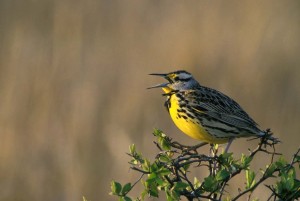We have much more to do and your continued support is needed now more than ever.
More Ways to Protect Wildlife Habitat in the 2012 Farm Bill
As the Senate and House Agriculture Committees begin work on a new farm bill, one major question they should consider is “how can we make sure that farm bill dollars are used wisely?” Earlier this month I blogged on why I think the farm bill is important to wildlife. This time, I want to discuss two major provisions to ensure that farm bill dollars are not being used to create incentives for practices that harm wildlife habitat.
Sodsaver is a proposed provision for the 2012 Farm Bill that makes land that has never been cropped ineligible for farm bill benefits. Sodsaver is particularly important because it would help protect America’s remaining native grasslands.
Under conservation compliance, landowners who receive farm bill benefits must follow a conservation plan on highly erodible land and refrain from draining wetlands. Compliance is already part of the farm bill, but it doesn’t apply to crop insurance, which is now the largest federal subsidy to farmers. Unless conservation compliance is connected to crop insurance in the next Farm Bill, millions of acres of wetlands could be drained, and soil erosion will increase.
3 Reasons Why Compliance and Sodsaver Make Sense

- Declining grasslands, wetlands, and native ecosystems are valuable public resources that need protection. Native prairie and grasslands are extremely valuable habitat for wildlife species, such as the Western Meadowlark, pictured right. A 2010 NWF article states that “40% of the entire continent’s declining bird species are those that depend on grasslands.” Wetlands are crucial wildlife habitats that also need protection; in Iowa alone, 99% of native wetlands have been lost over time, according to North Carolina State University. In addition to providing food and habitat for thousands of migratory birds and other animals, wetlands benefit the public by filtering nutrients and contaminants from water and absorbing excess water during floods.
- High crop prices are tempting farmers and landowners to grow crops on marginal or previously uncropped land. Last year was a record year for agriculture, with high exports and projected net farm incomes reaching a 10-year high according to USDA’s Economic Research Service. High crop prices encourage investors to get into the market while the getting is good; this means that more land gets converted to agricultural use, and valuable wetlands and grasslands are lost.
- It is not fiscally responsible to use taxpayer dollars to decrease the risk of farming marginal land. Uncropped land has been left that way for a reason—it’s not worth the effort. Marginal lands produce low crop yields and they are often susceptible to floods and erosion. Subsidized crop insurance reduces the risk so that farming marginal lands is more attractive, but this comes at the expense of taxpayers. Since our nation does not have a food shortage, and costs of insuring such land are often high, this means we foot the bill but don’t get much of a return for our money.
All of these are common sense reasons to include Sodsaver and conservation compliance in the next Farm Bill. Protecting wildlife habitat and saving taxpayer dollars makes sense for everyone. Stay tuned to this blog for important updates on the farm bill and how your money is spent. In the meantime, check out this article in NWF magazine on Farm Bill conservation.





















